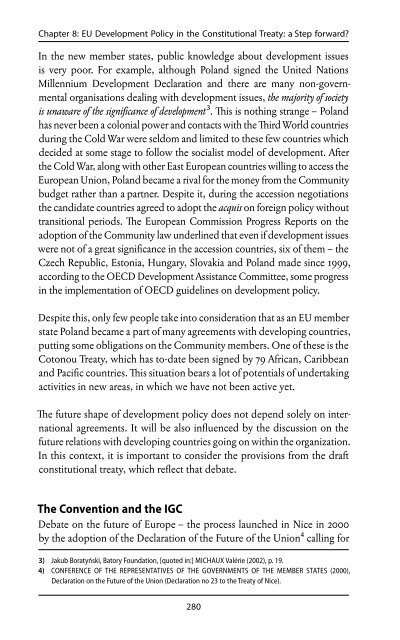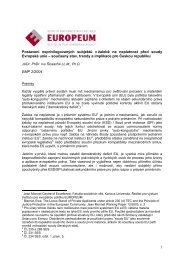eu constitutionalisation - EUROPEUM Institute for European Policy
eu constitutionalisation - EUROPEUM Institute for European Policy
eu constitutionalisation - EUROPEUM Institute for European Policy
Create successful ePaper yourself
Turn your PDF publications into a flip-book with our unique Google optimized e-Paper software.
Chapter 8: EU Development <strong>Policy</strong> in the Constitutional Treaty: a Step <strong>for</strong>ward?In the new member states, public knowledge about development issuesis very poor. For example, although Poland signed the United NationsMillennium Development Declaration and there are many non-governmentalorganisations dealing with development issues, the majority of societyis unaware of the significance of development³. This is nothing strange – Polandhas never been a colonial power and contacts with the Third World countriesduring the Cold War were seldom and limited to these few countries whichdecided at some stage to follow the socialist model of development. Afterthe Cold War, along with other East <strong>European</strong> countries willing to access the<strong>European</strong> Union, Poland became a rival <strong>for</strong> the money from the Communitybudget rather than a partner. Despite it, during the accession negotiationsthe candidate countries agreed to adopt the acquis on <strong>for</strong>eign policy withouttransitional periods. The <strong>European</strong> Commission Progress Reports on theadoption of the Community law underlined that even if development issueswere not of a great significance in the accession countries, six of them – theCzech Republic, Estonia, Hungary, Slovakia and Poland made since 1999,according to the OECD Development Assistance Committee, some progressin the implementation of OECD guidelines on development policy.Despite this, only few people take into consideration that as an EU memberstate Poland became a part of many agreements with developing countries,putting some obligations on the Community members. One of these is theCotonou Treaty, which has to-date been signed by 79 African, Caribbeanand Pacific countries. This situation bears a lot of potentials of undertakingactivities in new areas, in which we have not been active yet.The future shape of development policy does not depend solely on internationalagreements. It will be also influenced by the discussion on thefuture relations with developing countries going on within the organization.In this context, it is important to consider the provisions from the draftconstitutional treaty, which reflect that debate.The Convention and the IGCDebate on the future of Europe – the process launched in Nice in 2000by the adoption of the Declaration of the Future of the Union⁴ calling <strong>for</strong>3) Jakub Boratyński, Batory Foundation, [quoted in:] MICHAUX Valérie (2002), p. 19.4) CONFERENCE OF THE REPRESENTATIVES OF THE GOVERNMENTS OF THE MEMBER STATES (2000),Declaration on the Future of the Union (Declaration no 23 to the Treaty of Nice).280Chapter 8: EU Development <strong>Policy</strong> in the Constitutional Treaty: a Step <strong>for</strong>ward?a wide-ranging discussion with all interested parties – reached a key junctureat Laeken in December 2001. At this meeting the <strong>European</strong> Councildrew up a Declaration containing appropriate initiatives <strong>for</strong> the continuationof the debate in a more structured way. In the Laeken Declaration,EU leaders decided that:In order to pave the way <strong>for</strong> the next Intergovernmental Conference as broadlyand openly as possible the <strong>European</strong> Council has decided to convene a Conventioncomposed of the main parties involved in the debate on the future of the Union. Inthe light of the <strong>for</strong>egoing, it will be the task of that Convention to consider the keyissues arising <strong>for</strong> the Union’s future development and try to identify the variouspossible responses.A long list of questions (approximately 80) was identified in the declarationto be answered by this Convention. They were divided into categories offundamental questions about the role of the EU, division of competenciesin the <strong>European</strong> Union, simplification of the Union’s instruments, functioningof EU institutions and their democratic legitimacy, and a single voice<strong>for</strong> the EU in the world⁵.The Convention opened its proceedings in February 2002. Eleven workinggroups were set up to discuss the various issues. Working Group VII dealt withEU External Action and presented its final report in December 2002⁶. In July2003 a Draft Treaty establishing a Constitution <strong>for</strong> Europe (DCT)⁷ was presented,a document that <strong>for</strong>med the basis <strong>for</strong> negotiations at the IntergovernmentalConference (IGC), launched in October 2003. The IGC adopted the text ofthe constitutional treaty (CT) at the Brussels <strong>European</strong> Council on 18 June,2004⁸. The text has now to be ratified in all member states.In the external action area, which incorporates development cooperation,the member states agreed from the beginning on the necessity of establishinga stronger external policy, but had quite different opinions on how thisshould be carried out. First of all, there is a perceived conflict between EU5) CONFERENCE OF THE REPRESENTATIVES OF THE GOVERNMENTS OF THE MEMBER STATES (2001),Declaration on the Future of the <strong>European</strong> Union (quoted as: Laeken Declaration).6) EUROPEAN CONVENTION (2002), Final Report of Working Group VII on External Action, CONV 459/02.7) EUROPEAN CONVENTION (2003), Draft Treaty establishing a Constitution <strong>for</strong> Europe, CONV 850/038) CONFERENCE OF THE REPRESENTATIVES OF THE GOVERNMENTS OF THE MEMBER STATES (2004), Treatyestablishing a Constitution <strong>for</strong> Europe.281








